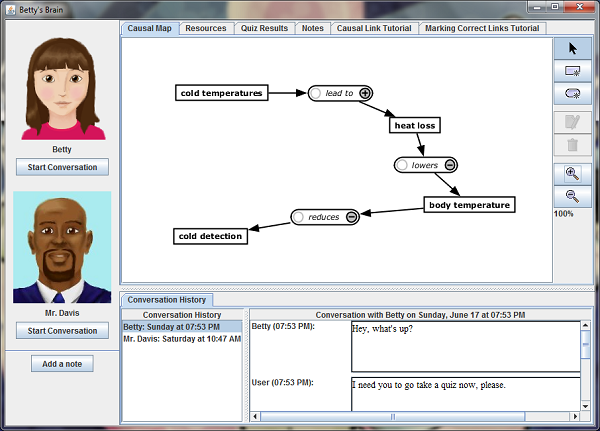
Highlight: In February 2014, Betty's Brain was featured in The Tennessean. You can read the article and watch a short video here.
Betty's Brain
Betty's Brain is a computer-based learning environment that utilizes the learning-by-teaching paradigm to engage students in learning about science topics. In Betty's Brain, students are charged with teaching a computer agent named Betty by constructing a causal model of the systems or processes that make up that science topic (e.g., ecosystems, climate change, or thermoregulation). To do this well, the student must become a responsible learner and teacher. The system includes hypertext resources that describe the topic under study, and students are expected to read the resources and model their emerging understanding of the topic. To be a good teacher, students need to keep track of how much Betty is learning. They can do this by asking Betty to answer questions and take quizzes. For example, in the map below, students could ask Betty to explain how cold temperatures affect a person's body temperature. Betty uses the causal map she has been taught to answer the qeustions.

Each topic in Betty's Brain includes an expert model that corresponds to the information in the resources. The student's overall goal while using the system is to learn the scientific topic well enough to be able to teach Betty this expert model. To gauge Betty's understanding (and their own), they can have Betty take quizzes, which are sets of questions created dynamically by Mr. Davis. Mr. Davis grades Betty's quiz answeers and keeps track of how well she is performing. Additionally, he monitors the students' actions as they go about their learning and teaching tasks. He uses a combination of this information to guide and mentor the students as they work. The quizzes are designed to provide students with feedback on the correctness and completeness of their model, and students can use this information to determine where they may have made errors in teaching Betty, and also where they may need to add or correct links in their existing model.
Betty's Brain presents students with an open-ended learning task: students are free to choose what they learn, how they learn, and how they may go about teaching their agent. Some students prefer to model their current understanding before they begin reading the resources, and other students prefer to read the resources in their entirety before they begin putting together their model to teach Betty. Students also exhibit variation in how they seek information. Some students adopt a sequential approach: they read the resources one page at a time to find links for the causal model. Other students systematically divide the overall learning task into sub-goals: these students work to achieve their overall task one sub-goal at a time. Similarly, there are many different ways in which students may choose to check the correctness of the causal map they are building. The large set of choices the students have defines the open-ended nature of the learning task. To be successful, students have to take control of their learning activities and find ways to regulate their learning, so as not to be overwhelmed by the task. Research has established that, if done properly, learning by exploring and model building leads to deeper learning.
However, for a variety of reasons, students struggle to manage their own learning processes. To help these students achieve success in the Betty's Brain environment, we have designed the system to provide students with dynamic scaffolding and feedback to help them learn about, practice, and gain proficiency in the reading, modeling, planning, and monitoring activities crucial for success not only in Betty's Brain, but also in future learning endeavors outside of the learning environment.
"; generate_page_end(); ?>